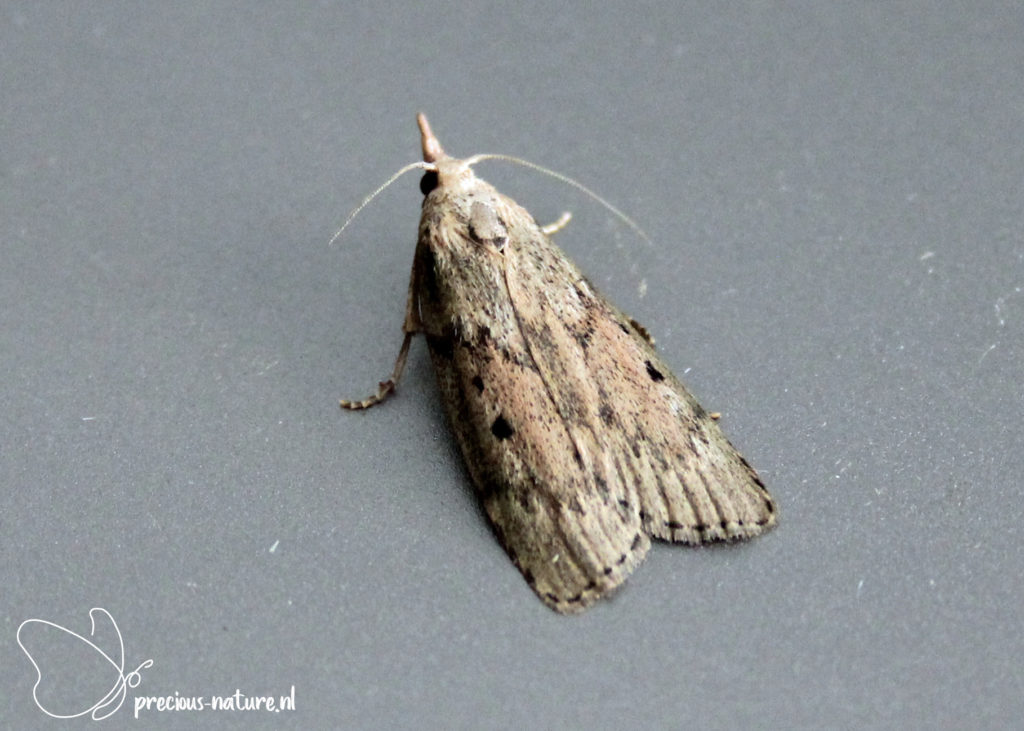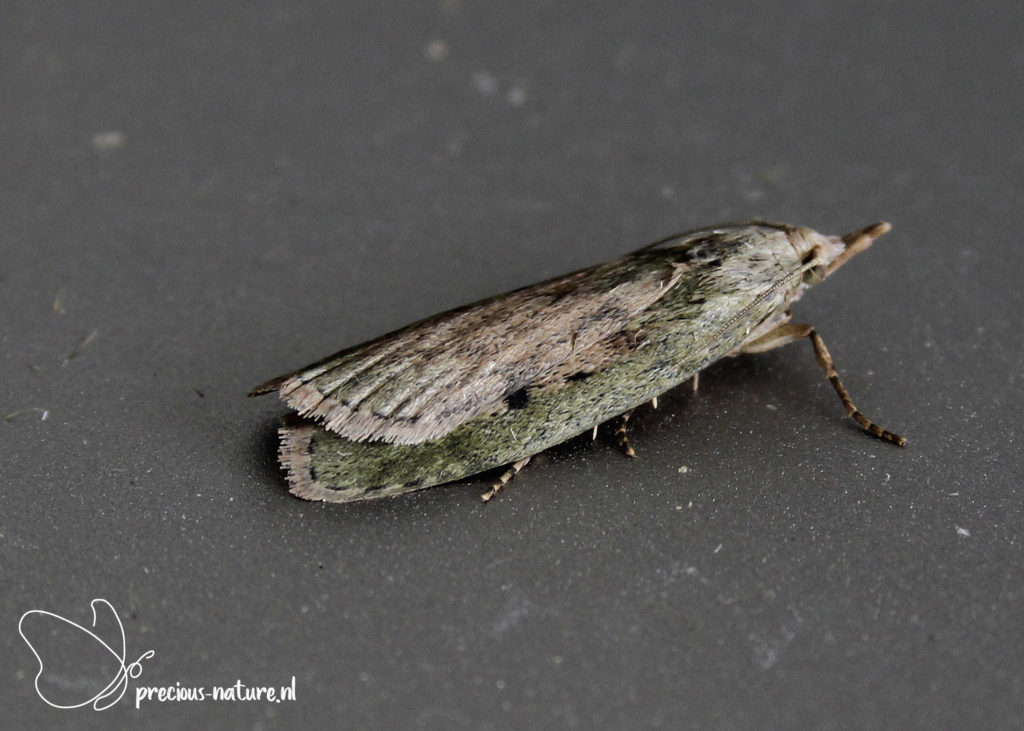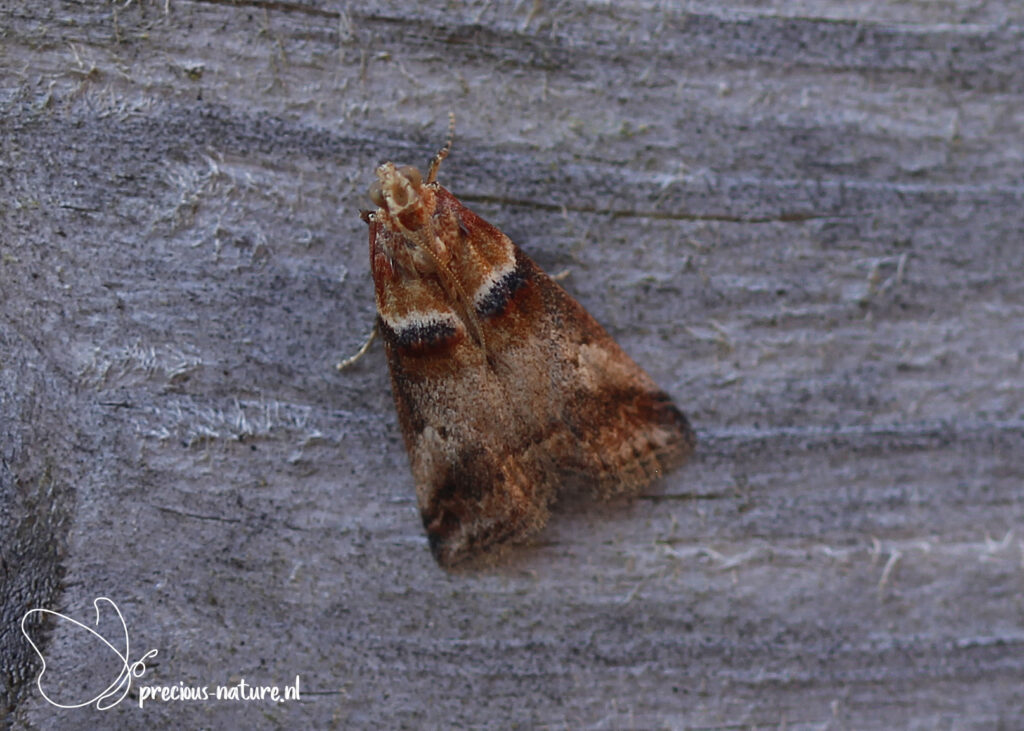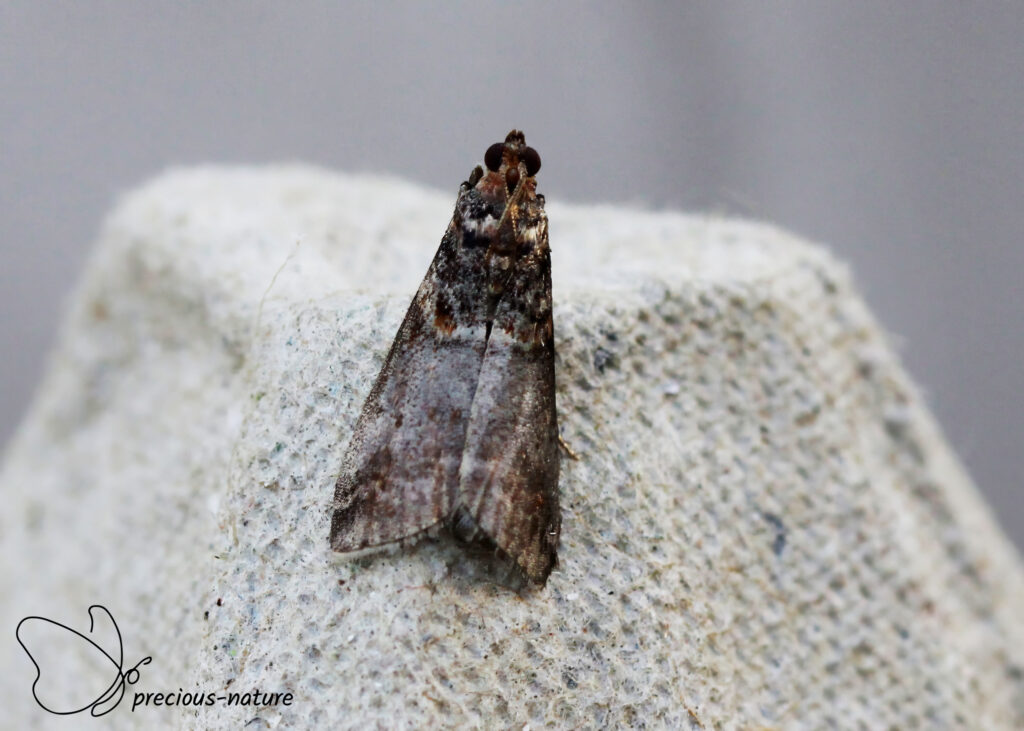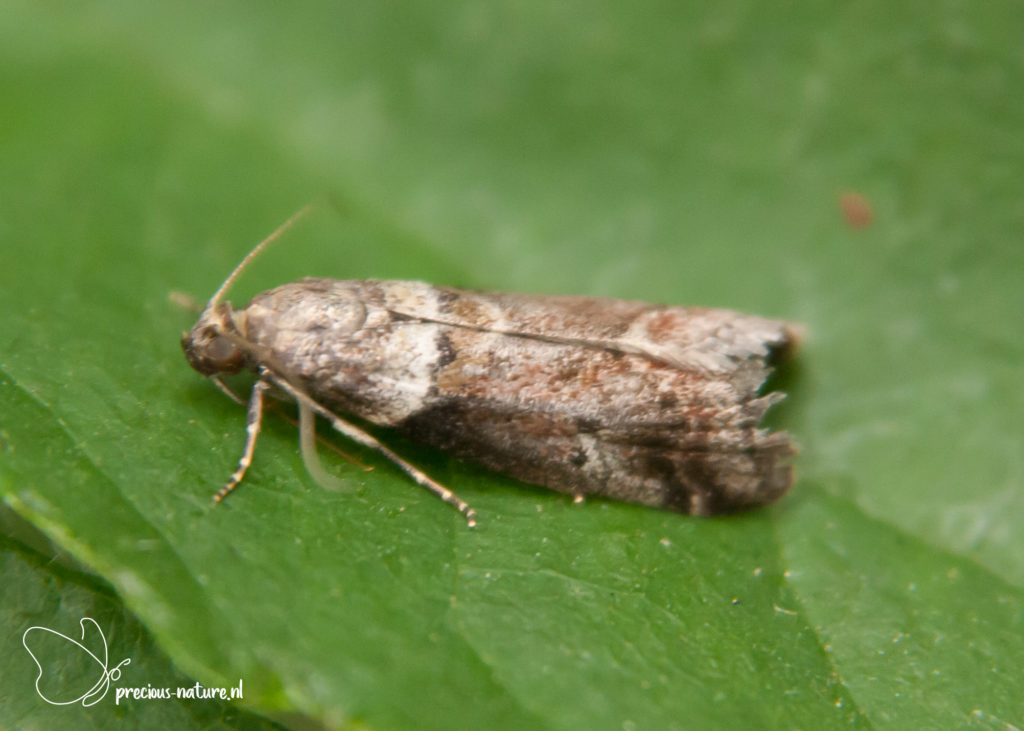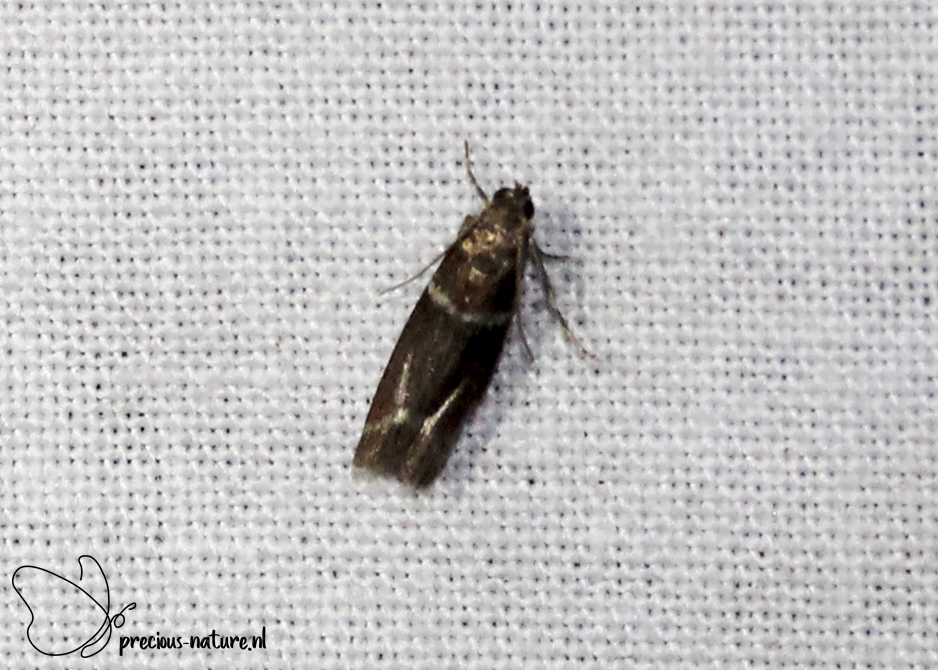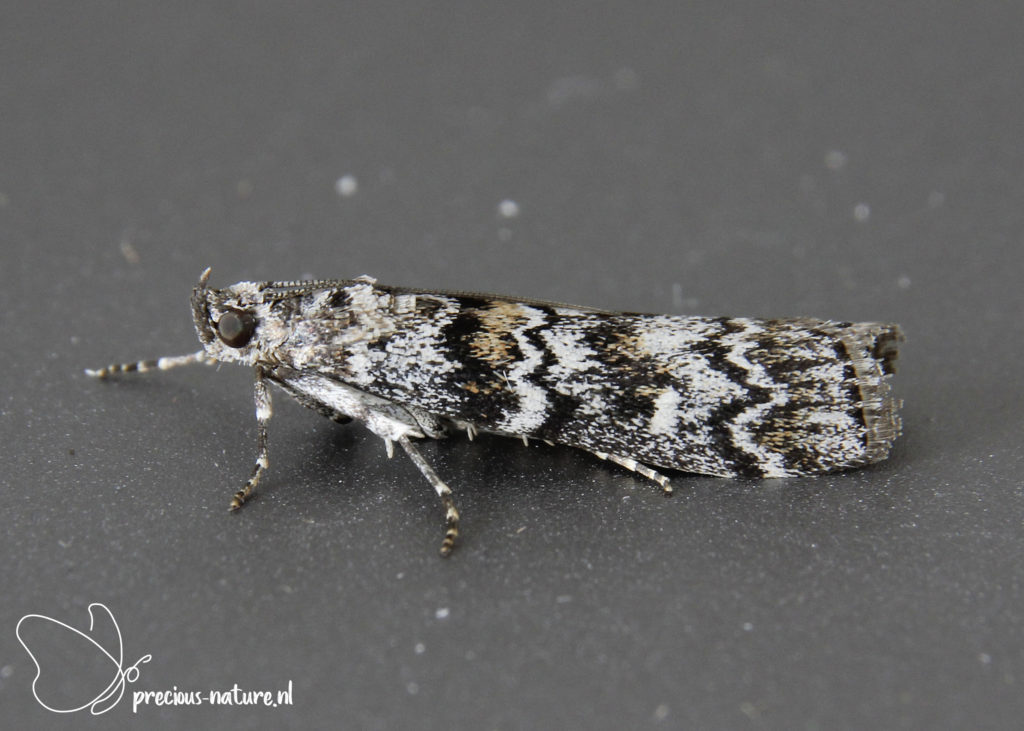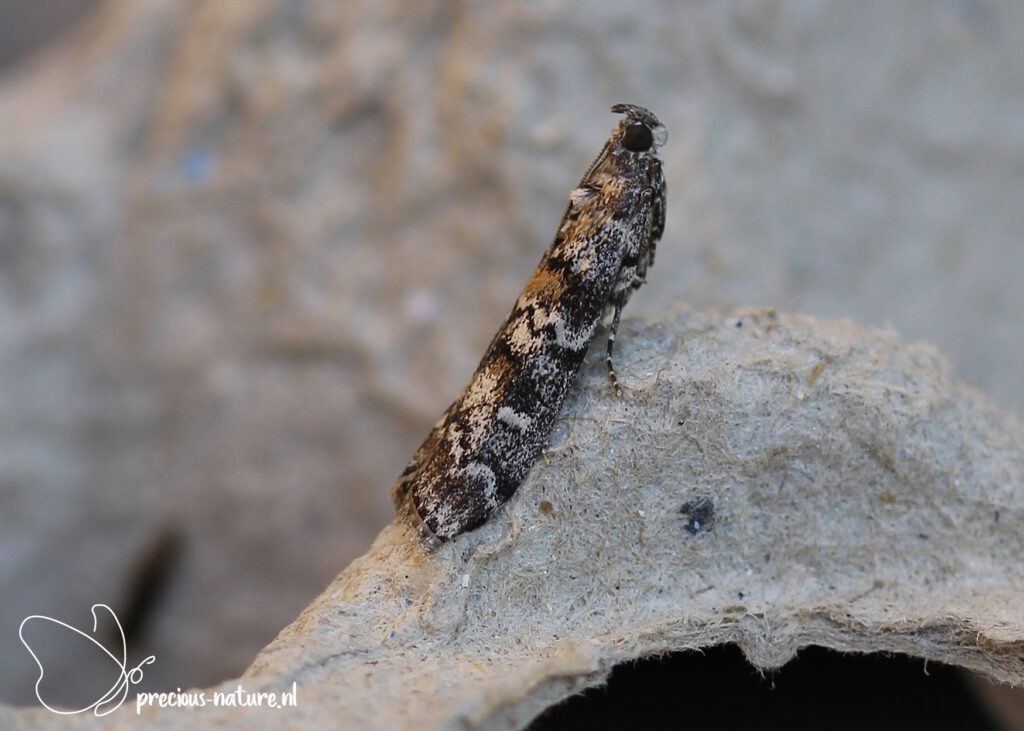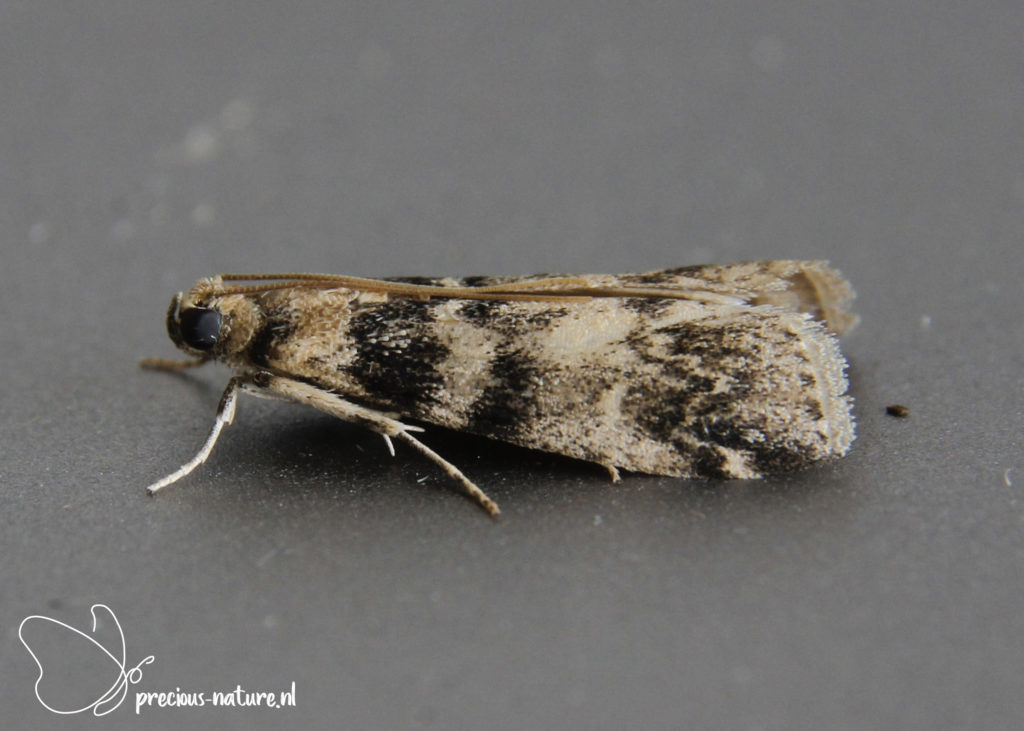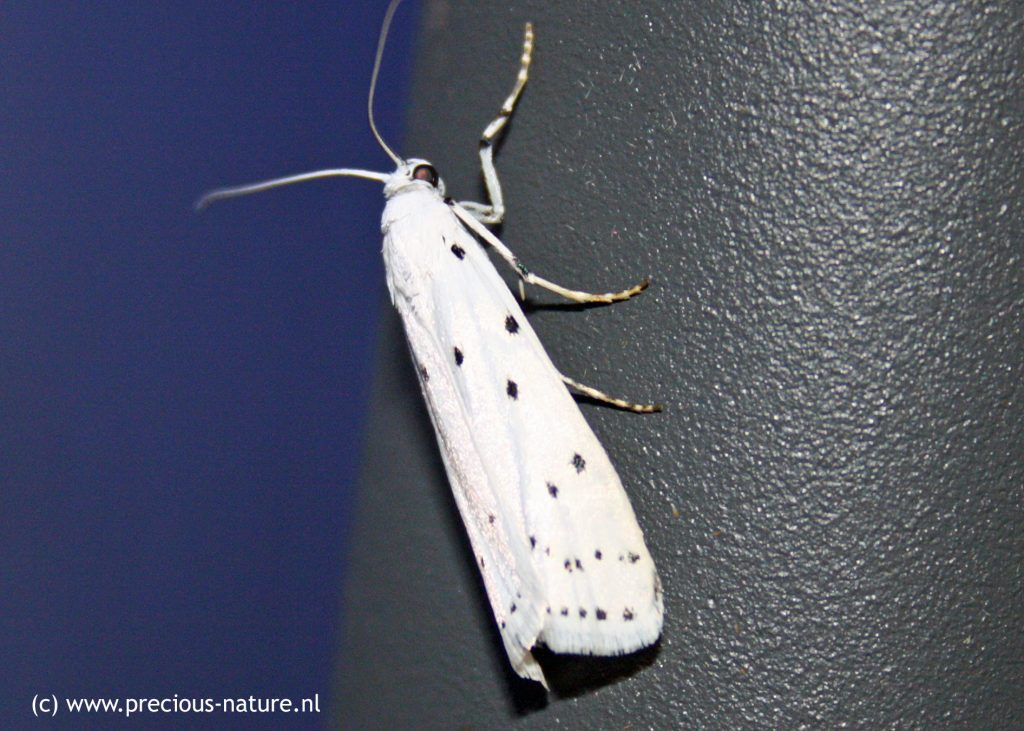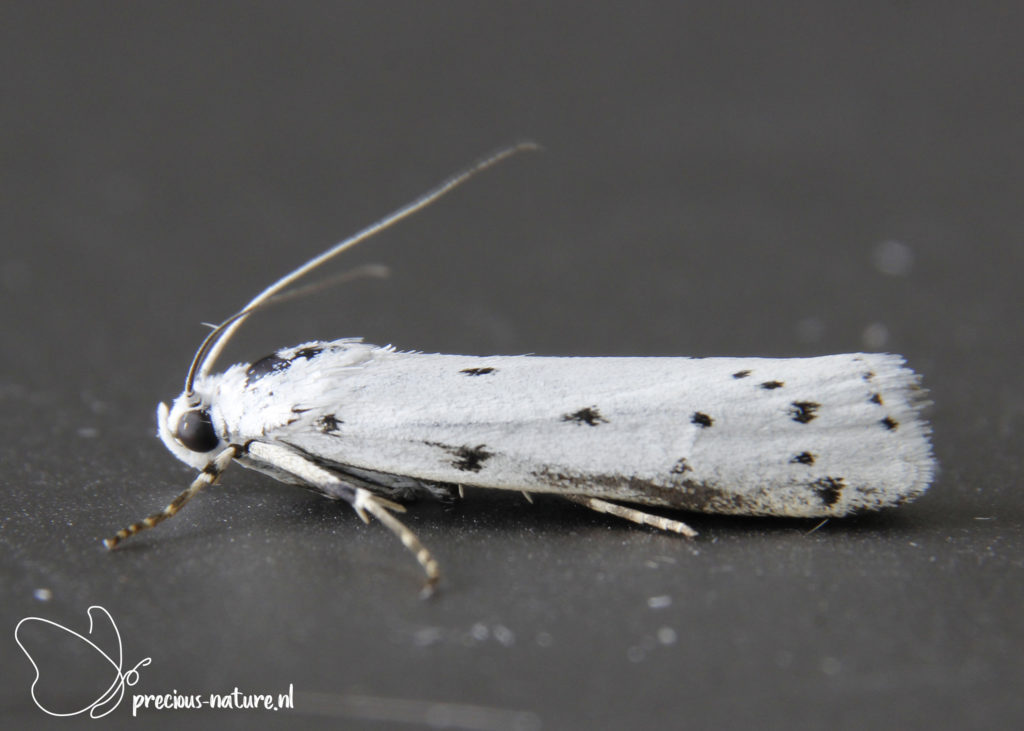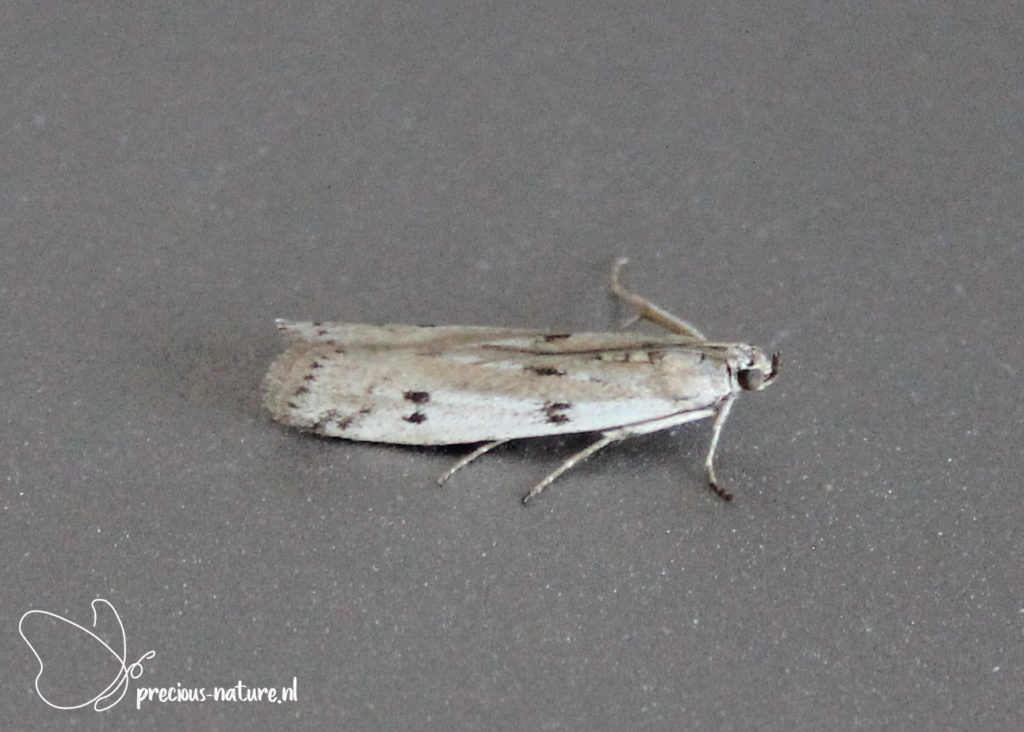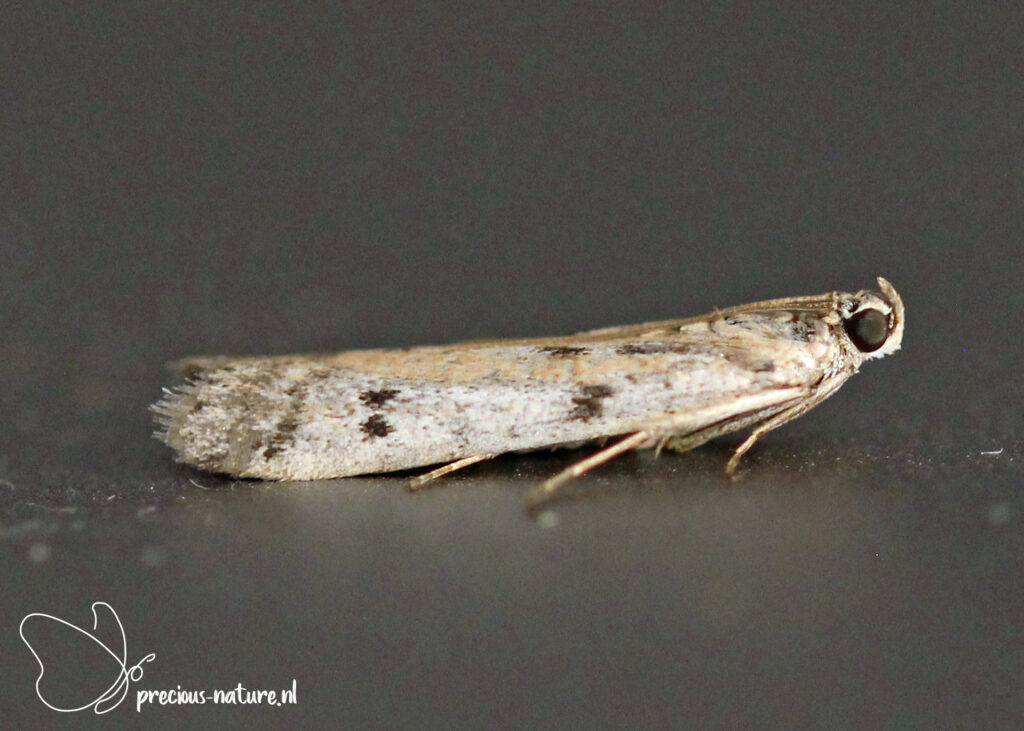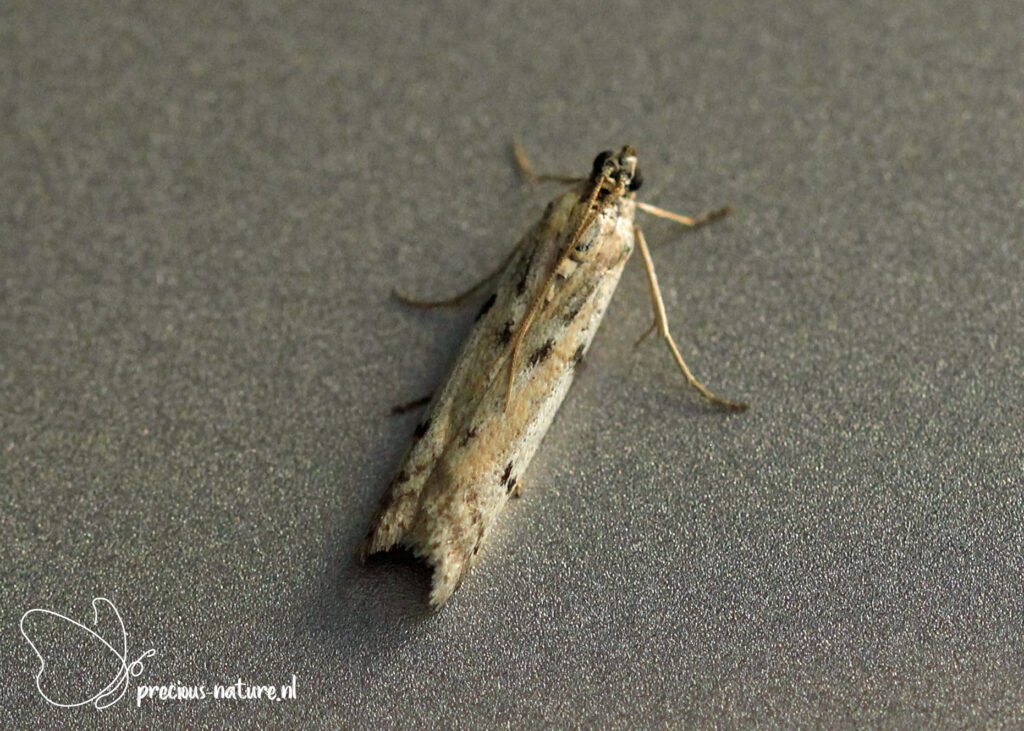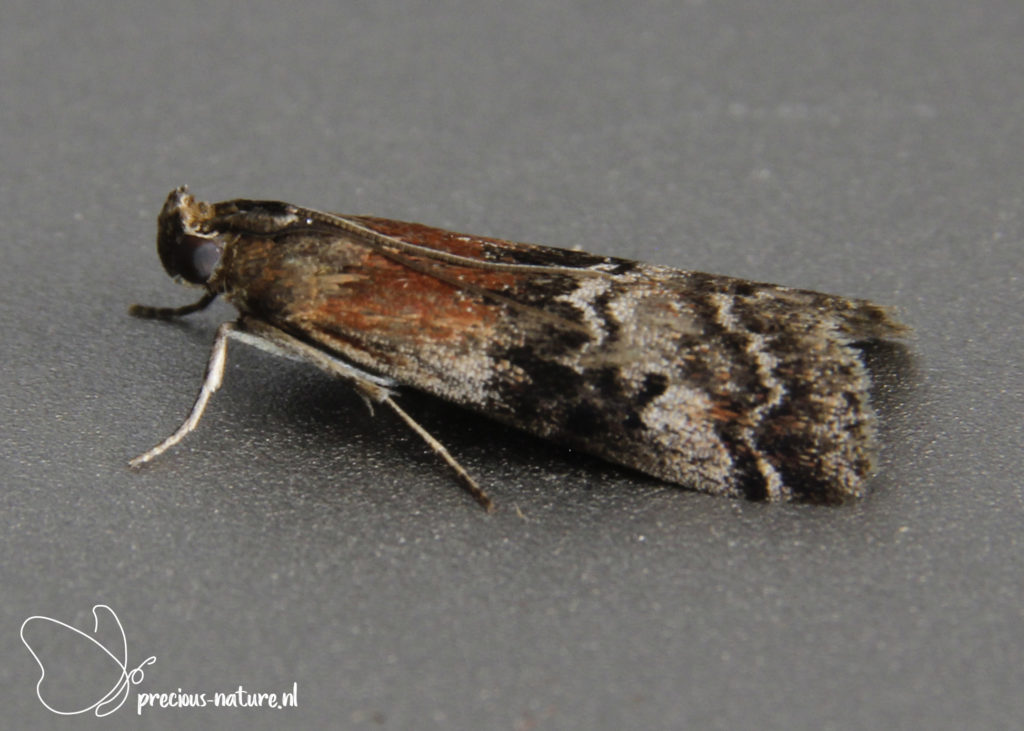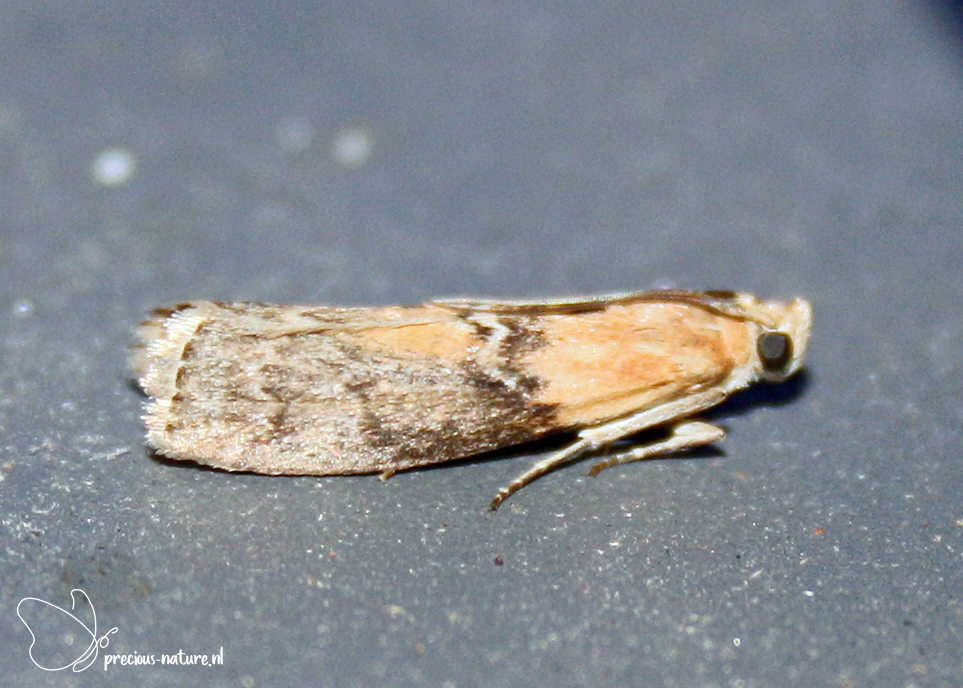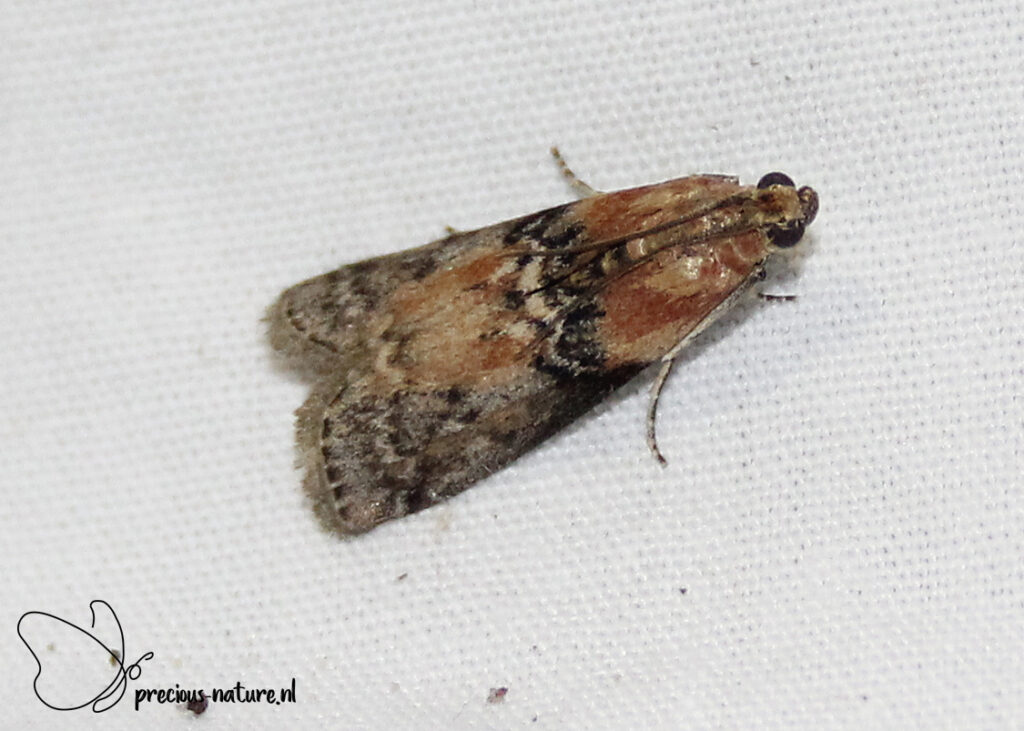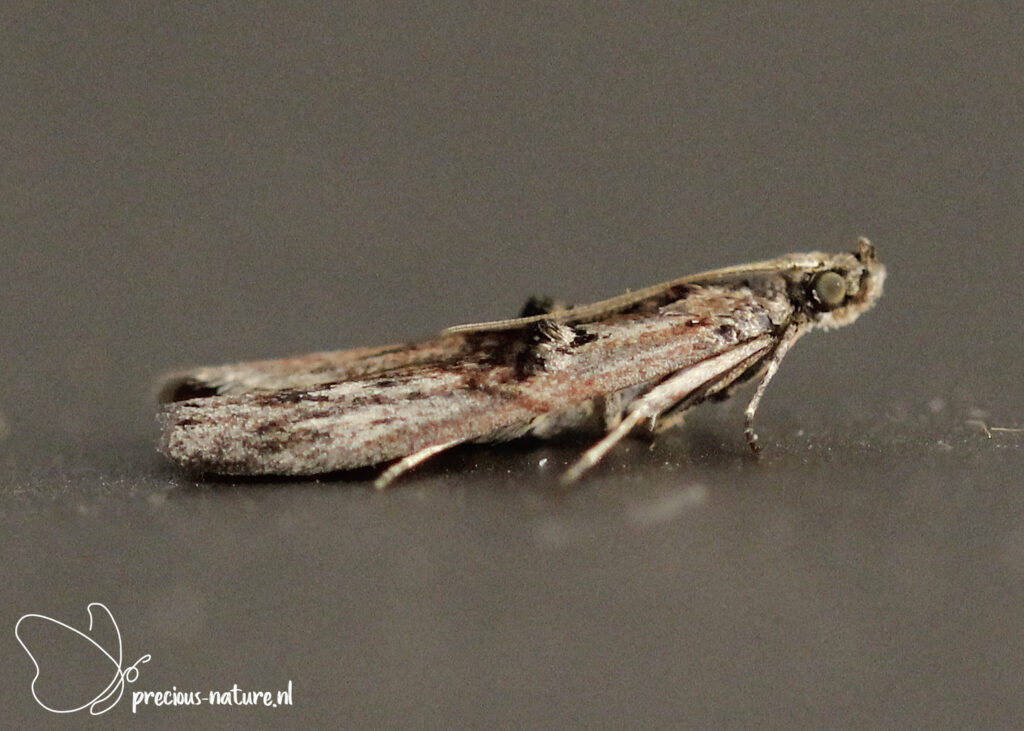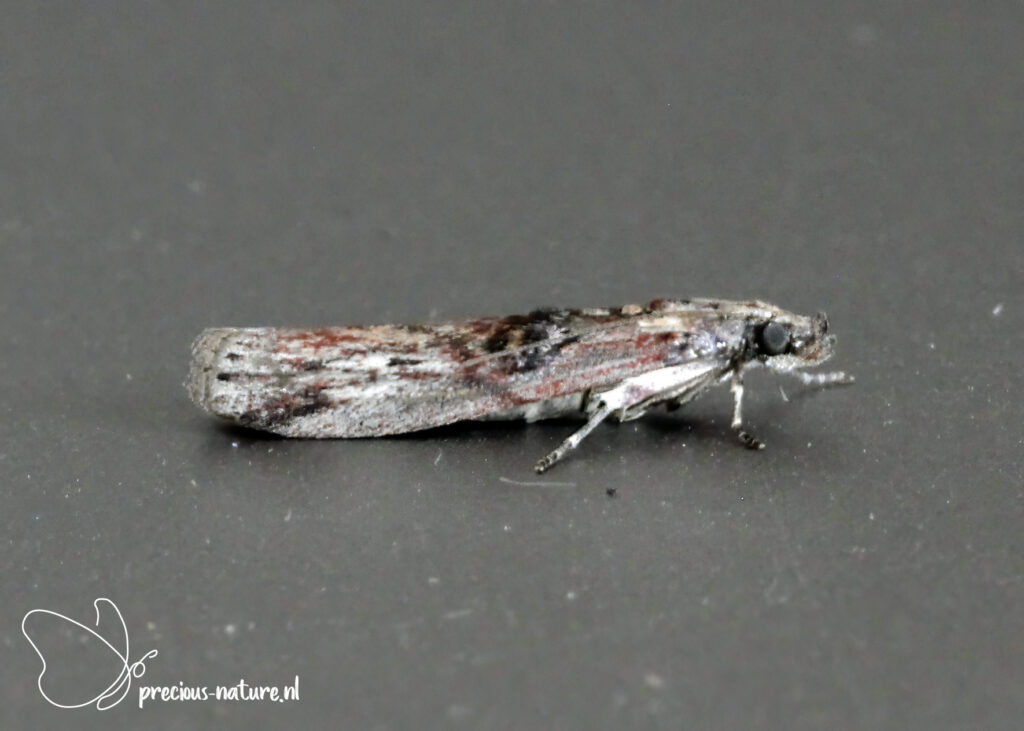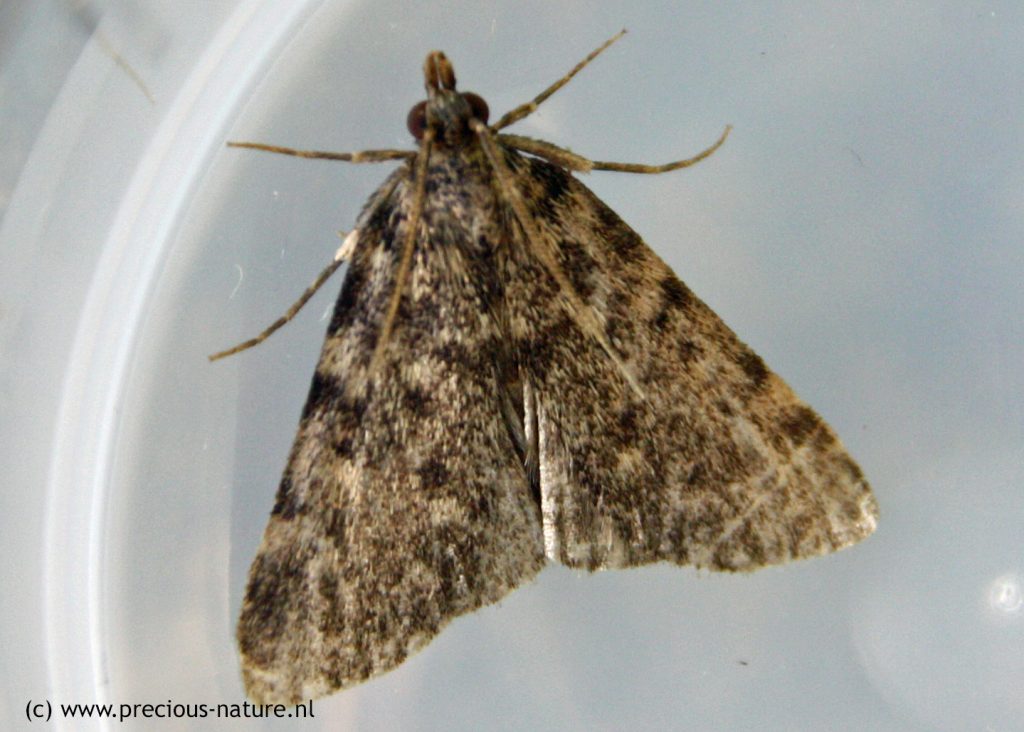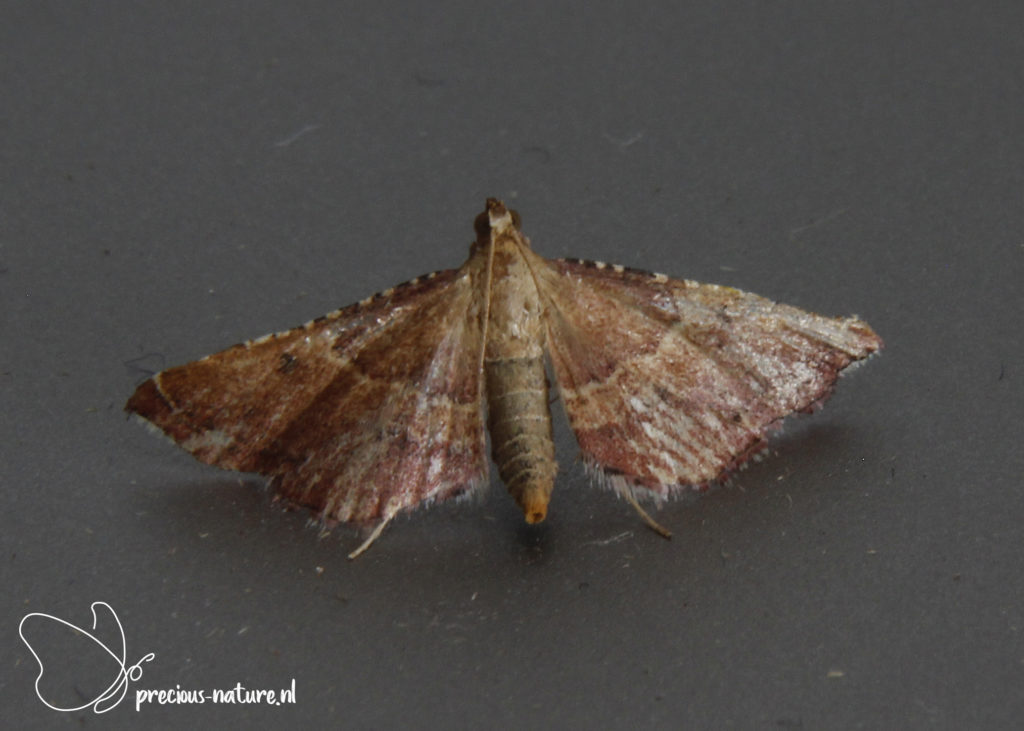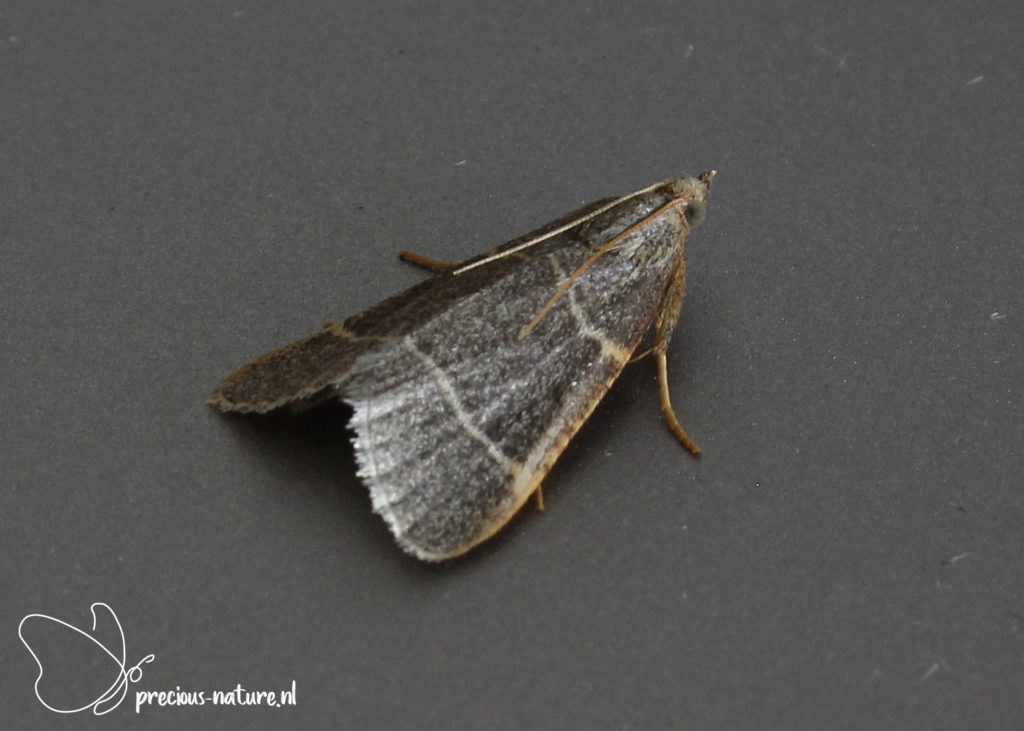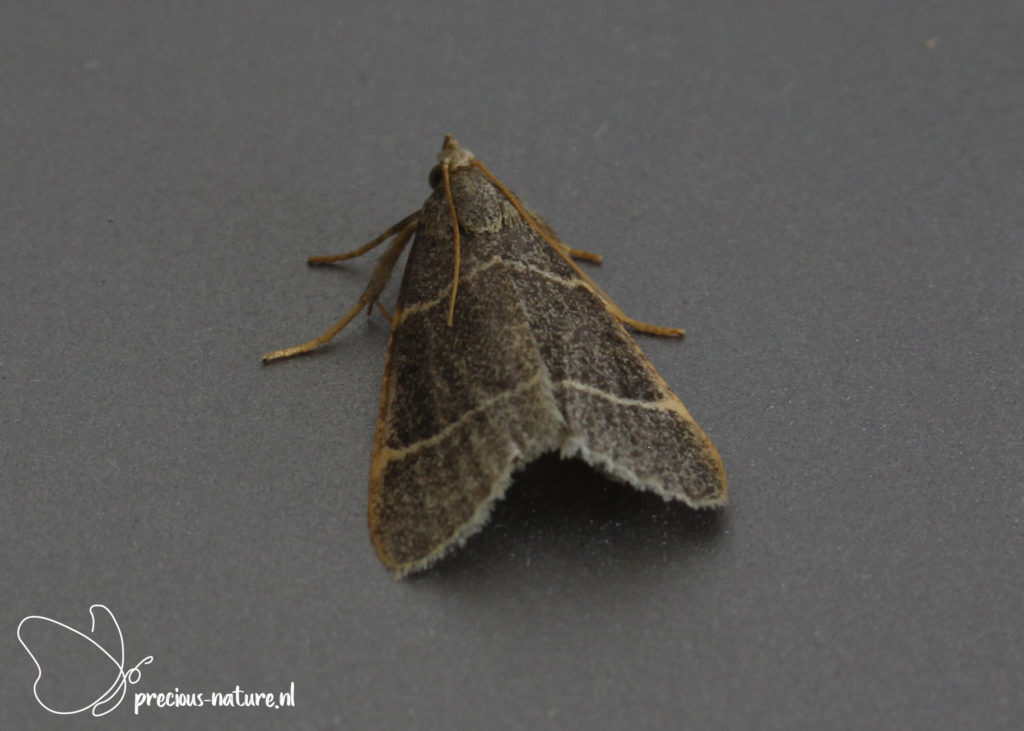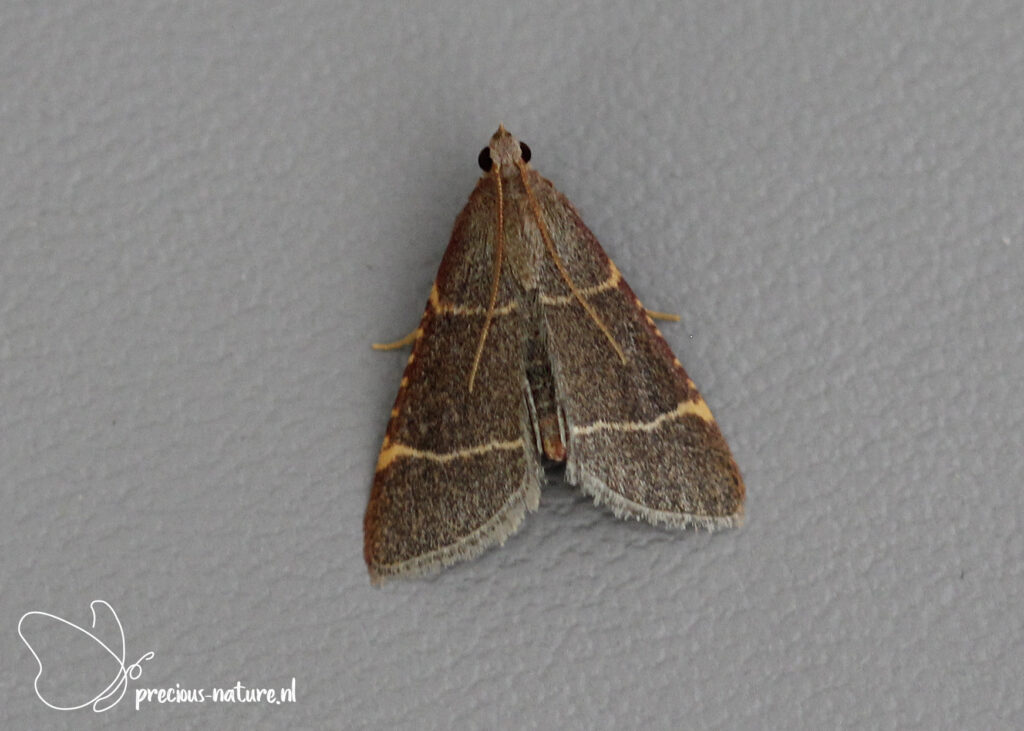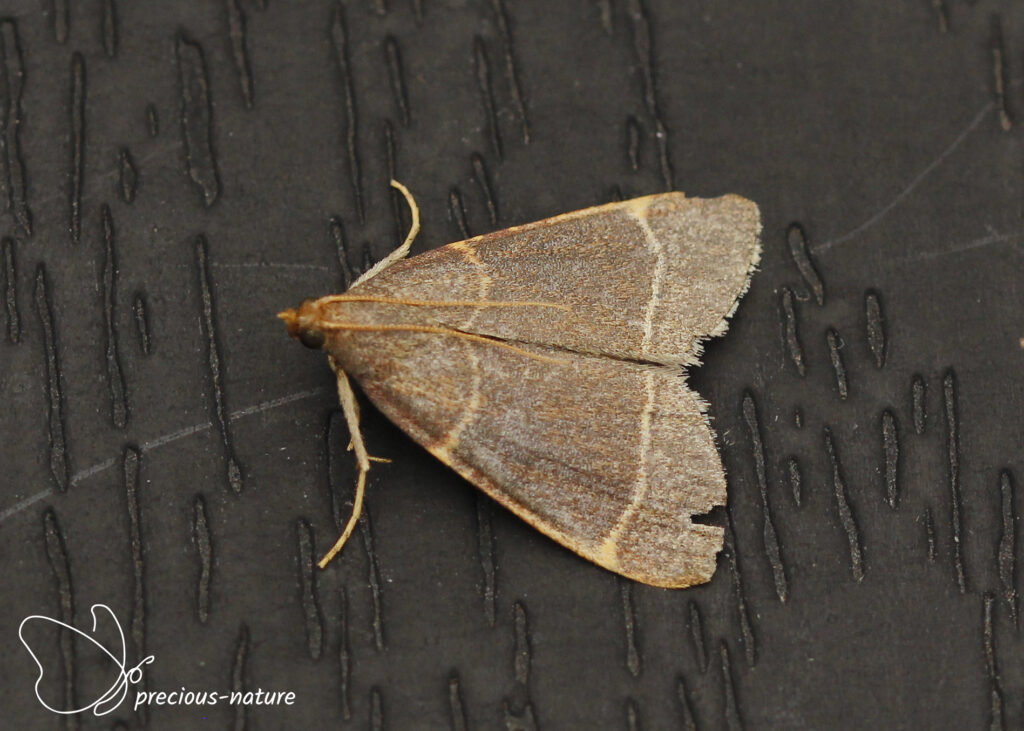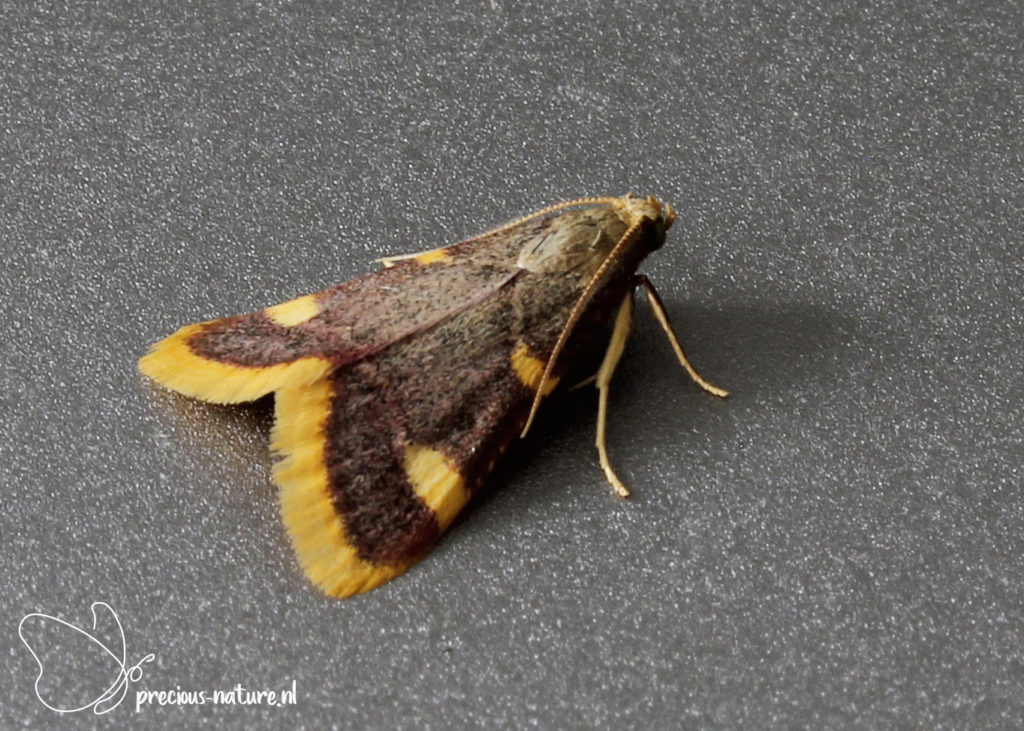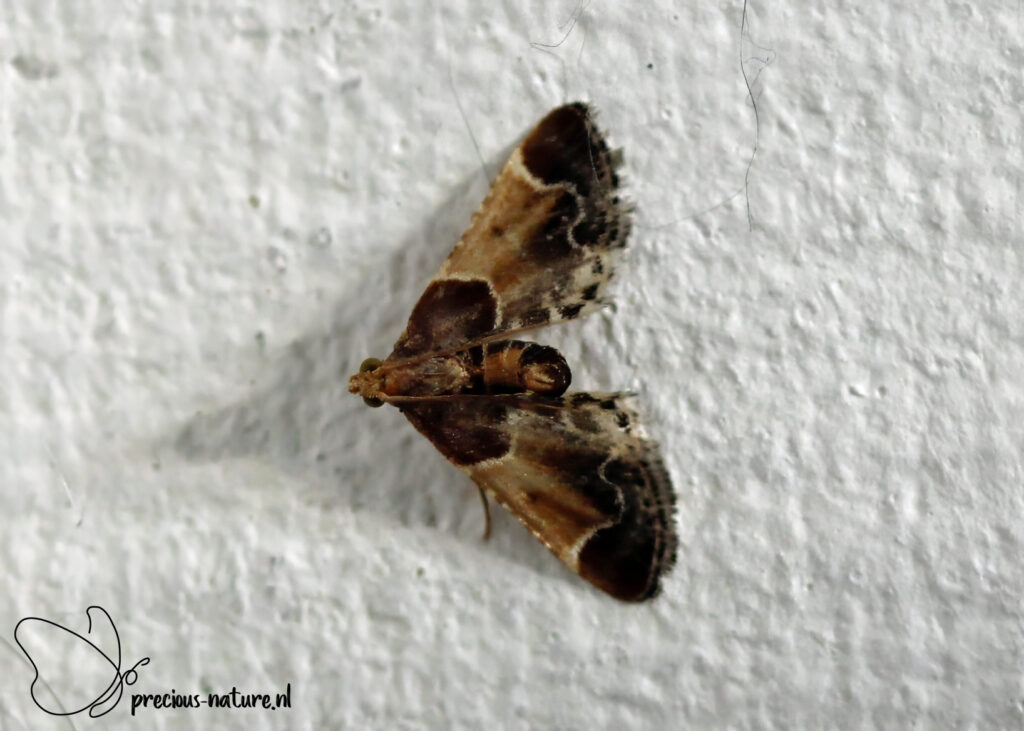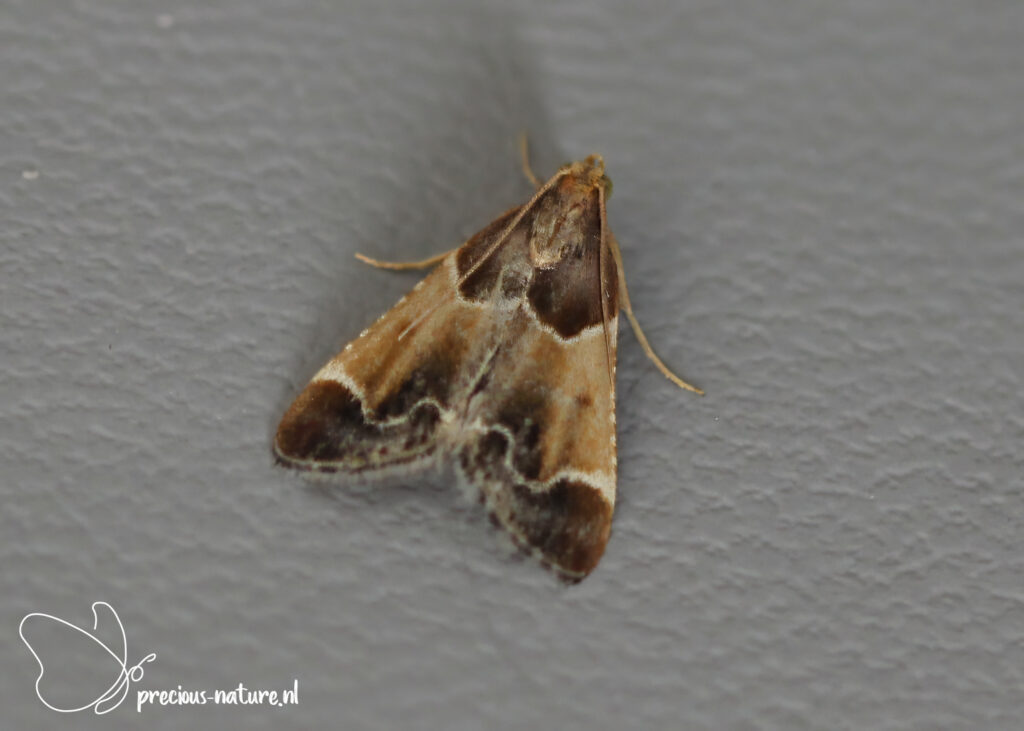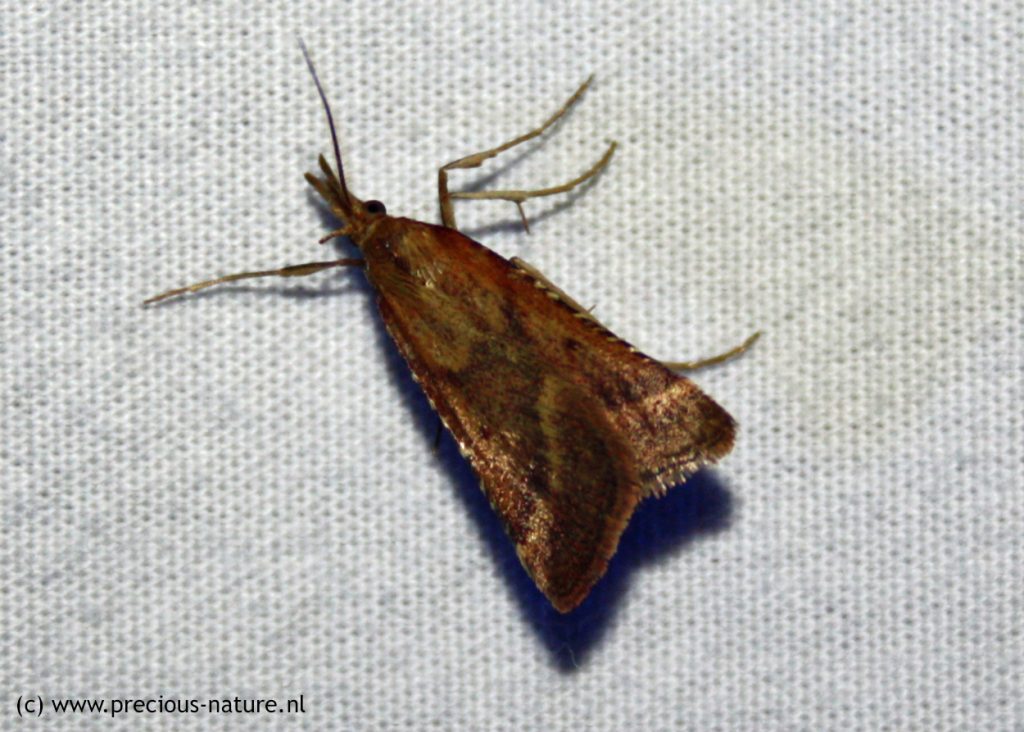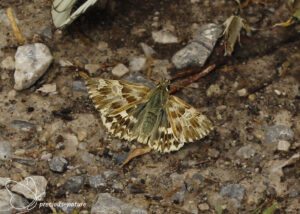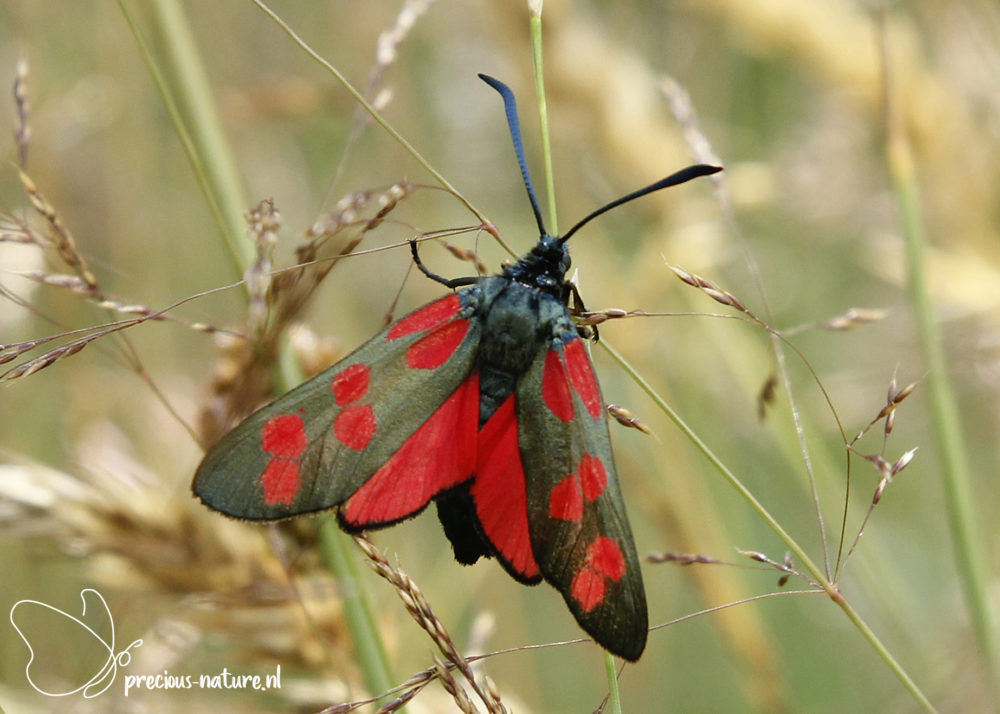The Snout Moths (Pyralidae) are also called light moths. They can have wide or narrow forewings and broad and rounded hindwings. The palps of some species have grown into long snouts. Most of the species are fairly unremarkable in colour, and the wingspan varies from 10 to 46 mm. When they are at rest, the antennas are placed on the wings and not underneath, as sometimes happens with other moths.
Subfamily: Galeriinae
Genus: Aphomia
Bee Moth – 2017 (NL)
(NCBI-index: 688398)
The male and female of the Bee Moth (Aphomia sociella) look different. The female is slightly larger, brownish, and has three distinct bands across the forewings, separated by sharp, coarse-toothed zigzag lines. The median band, which is slightly darker than the other two, has a black dot. The hindwing is almost uniformly light brown. The male has a more contrasting colour. The base of the forewing is almost white, followed by a darker part. The base colour becomes slightly lighter towards the apex. The zigzag bands are only partially present, and the wings are therefore less clearly divided into three parts. The hindwing is whitish brown, darkening at the edges. The flying period spans from May to October in one generation, and the wingspan ranges from 18 to 44 mm. Host plant: In the nests of bumblebees and wasps. Dutch name: Hommelnestmot. Frisian name: –
Flying period:

Subfamily: Phycitinae
Genus: Acrobasis
Warted Knot-horn – 2018 (FR)
(NCBI-index: 1.100902)
A striking snout moth, because of its bright orange colour, is the Warted Knot-horn (Acrobasis repandana). The forewing is half orange from the base, and the rest of the wing is light grey. On 1/3, in the orange part, a white and black cross line. The flying period in one generation is from June to September, and the wingspan is 20-25 mm. Host plant: Oak. Dutch name: Oranje eikenlichtmot. Frisian name: –
Flying period:

Subfamily: Phycitinae
Genus: Acrobasis
Grey Knot-horn – 2018 (FR)
(NCBI-index: 1.594216)
The Grey Knot-horn (Acrobasis advenella) has a silver-grey forewing with red-brown or black-brown shades. The wing base is usually darker than the rest of the wing. On 1/3 is a distinct black cross band followed by a reddish-brown band and a cream-colored line. This snout moth is very similar to the Thicket Knot-horn (Acrobasis suavella). The Grey Knot-horn, however, is slightly smaller and does not have a distinct black spot near the apex. Furthermore, two black dots are aligned towards the termen where they are aligned just the other way on the Thicket Knot-horn. The flying period in one generation is from May to September, and the wingspan is 18-24 mm. Host plant: Hawthorn, Mountain Ash. Dutch name: Mutsjeslichtmot. Frisian name: –
Flying period:

Subfamily: Phycitinae
Genus: Acrobasis
Broad-barred Knot-horn – 2019 (NL)
(NCBI-index: 1.100900)
A day of walking around in a nature reserve in Gelderland resulted in a new snout moth, the Broad-barred Knot-horn (Acrobasis consociella). This tiny moth, an inch or so, has a greyish-white forewing with a coppery sheen after the thin black crossline that sits at 1/3. Just before that transverse line is a white zone. At the end of the wing is a dark brown wavy transverse line. Just before that, two black dots are visible. The oak-topped moth resembles the Dusty Knot-horn (Acrobasis sodalella), which, however, is much stronger and marked. The flying period in one generation is from the end of May to August, and the wingspan is 19-22 mm. Host plant: Oak. Dutch name: Eikentopspinselmot. Frisian name: –
Flying period:

Subfamily: Phycitinae
Genus: Cryptoblabes
Double-striped Knot-horn – 2020 (NL)
(NCBI-index: 1.100962)
One species that I would not have recognised so quickly from the first specimen I saw concerns the Double-striped Knot-horn (Cryptoblabes bistriga). An expert pointed out this little snout moth to me. The forewing is normally reddish-brown to purplish and darker between the two whitish cross-lines. In the basal area and towards the termen, the forewing is sometimes greyer or whitish. The flying period in one generation is from May to September, and the wingspan is 18-20 mm. Host plant: Oak. Dutch name: Boslichtmot. Frisian name: –
Flying period:

Subfamily: Phycitinae
Genus: Dioryctria
Dark Pine Knot-horn – 2021 (NL)
(NCBI-index: 305662)
A beautifully mottled and marked snout moth is the Dark Pine Knot-horn (Dioryctria abietella). The forewing is silver-grey with black speckles, with a silver-grey wavy transverse line on 1/3 that is black on the outside. On the base of the wing is a light orange spot and a wider black transverse line. On 4/5, there is another white with a black wavy line on the inside. There is a typical white spot between the two wavy lines. The flight period spans one generation, from June to mid-October, and the wingspan ranges from 26 to 32 mm. Host plant: Scots Pine, Norway Spruce, Noble Spruce, Larch. Dutch name: Sparappelboorder. Frisian name: –
Flying period:

Subfamily: Phycitinae
Genus: Euzophera
Tabby Knot-horn – 2018 (NL)
(NCBI-index: 1.366396)
The Tabby Knot-horn (Euzophera pinguis) has a yellow-brown forewing sometimes with a pinkish tint. The wing is black from the base with an indistinct yellow-brown spot. At 1/3, a zigzagging light yellow cross line can be seen. The middle part of the wing is colored light yellow, followed by a black zigzag cross line. The flying period is from June to September in one generation, and the wingspan is 23-28 mm. Host plant: Ash. Dutch name: Tweekleurige lichtmot. Frisian name: –
Flying period:

Subfamily: Phycitinae
Genus: Myelois
Thistle Ermine – 2018 (NL)
(NCBI-index: 1.870673)
This snout moth initially reminded me of an ermine moth (Yponomeutidae), but it is much larger and has a different resting position. The Thistle Ermine (Myelois circumvoluta) has a glossy white, silvery forewing with a few black spots. The spots closer to the dorsum are often larger, and there is a row of small black dots along the termen. The flying period in one generation is from May to September, and the wingspan is 27-33 mm. Host plant: Thistle. Dutch name: Distelhermelijntje. Frisian name: –
Flying period:

Subfamily: Phycitinae
Genus: Phycitodes
Ermine Knot-horn – 2019 (NL)
(NCBI-index: 1.101032)
It is because I use green egg boxes in my moth trap, otherwise the Ermine Knot-horn (Phycitodes binaevella) would hardly have caught my eye. This small moth is gray-white with some lighter strokes running the length of the wing. On 1/3 is a lighter median band with three elongated black dots in a straight line. Furthermore, two striking black dots can be seen on about 2/3 of the wing. The Ermine Knot-horn is slightly larger than similar species. The flying period spans from May to September in one generation, and the wingspan ranges from 22 to 27 mm. Host plant: Spear Thistle. Dutch name: Weidemot. Frisian name: –
Flying period:

Subfamily: Phycitinae
Genus: Rhodophaea
Beautiful Knot-horn – 2021 (NL)
(NCBI-index: 1.870710)
The base of the forewing of the Beautiful Knot-horn (Rhodophaea formosa) is brown-red with a white stripe along the leading edge. Midway through the wing, a distinct black transverse band is seen, which is widest at the leading edge and is bordered by a thin white wavy transverse line followed by a thin black wavy transverse line. Near the rear edge is also a white wavy transverse line that is black on both sides. Along the rear edge is a row of black dots. The wingspan is 20-23 mm, and the flight period is in one generation from late May to September. Host plant: Elm. Dutch name: Veelkleurig lichtmot. Frisian name: –
Flying period:

Subfamily: Phycitinae
Genus: Sciota
Willow Knot-horn – 2018 (NL)
(NCBI-index: 471164)
A striking micro-moth in terms of colour contrast is the Willow Knot-horn (Sciota adelphella). The forewing is light brown to orange close to the base. Furthermore, the wing is grey with white speckles. An orange-brown surface can be seen along the lower wing edge. Striking is the short, white, angular cross band on 1/3 of the forewing. The flying period in one generation is from May to August, and the wingspan is 13-14 mm. Host plant: Willow. Dutch name: Bandlichtmot. Frisian name: –
Flying period:

Subfamily: Phycytinae
Genus: Sciota
Spindle Knot-horn – 2022 (NL)
(NCBI-index: 1.594312)
I follow the Latin name for the genus of the Spindle Knot-horn (Sciota angustella) as indicated by the NCBI. In general, the name Nehopterix is used for the genus. The forewing is narrow, grey, and variegated reddish-brown and white speckled. The veins are black halfway through the wing, and further on, you see a pale red and black cross band on 1/3, followed by a strip of upright black scales, so that in the resting position, you see a kind of crest. The flight period spans two generations, from late April to November, and the wingspan measures 20-25 mm. Host plant: Spindle. Dutch name: Kraagvleugelmot. Frisian name: –
Flying period:

Subfamily: Pyralinae
Genus: Aglossa
Large Tabby – 2018 (NL)
(NCBI-index: 753149)
The Large Tabby (Aglossa pinguinalis) takes its Dutch name from pit grease, the grease or oily material that is secreted in the grease trap. This snout moth was often found in greasy barns. Now you often see him in the house, cellar, or shed. The forewing is dull yellow-brownish with a black-brown glow. On the wing is a yellow-brown zigzag transverse line on 2/3 that curves around a black dot. The flying period in one generation is from June to September, and the wingspan is 29-38 mm. Host plant: Grain waste, seeds, and hay. Dutch name: Vetmot. Frisian name: –
Flying period:

Subfamily: Pyralinae
Genus: Endotricha
Rosy Tabby – 2017 (NL)
(NCBI-index: 1.101095)
The Rosy Tabby (Endotricha flammealis) is a moth that also has a specific resting position. The front part of the body is then raised so that the front legs are straight. The wings are held at an angle such that the edges touch the body. The ground colour of the wing is brown-yellow with a broad median band that is either lighter or darker (reddish-brown). The flight time is from July to September, with the butterfly resting in deciduous trees between the leaves during the day. The wingspan is 18-22 mm. Host plant: Greater Bird’s-foot Trefoil. Dutch name: Strooiselmot. Frisian name: –
Flying period:

Subfamily: Pyralinae
Genus: Hypsopygia
Double-striped Tabby – 2017 (NL)
(NCBI-index: 1.101111)
The Double-striped Tabby (Hypsopygia glaucinalis) has both a mid-brown fore- and hindwing. Two yellowish transverse lines run across the wing. The flight time is from July to September, and the wingspan is 23-31 mm. Host plant: Hay. Dutch name: Tweelijnmot. Frisian name: –
Flying period:

Subfamily: Pyralinae
Genus: Hypsopygia
Gold Triangle – 2017 (NL)
(NCBI-index: 1.101110)
The Gold Triangle (Hypsopygia costalis) is a striking moth with purplish wings. On those wings, there are two light yellow spots along the costa of the forewing. The fringe line is yellow. In a resting position, the four wings are spread, and the abdomen rises or the wings are folded, making the moth look like a triangle. The flight time is from July to September, and the wingspan is 16-23 mm. Host plant: Hay and thatched roof. Dutch name: Triangelmot. Frisian name: –
Flying period:
![]()
Subfamily: Pyralinae
Genus: Pyralis
Meal Moth – 2012 (NL)
(NCBI-index: 687122)
The Meal Moth (Pyralis farinalis) is a very recognisable moth with dark brown wings with a very wide light brown band. A thin white line characterises the division between the dark brown and light brown bands. In a resting position, the hind wings are often folded under the forewings, and the abdomen curls upwards. The flight time is from June to August, and the wingspan is 18-30 mm. Host plant: Grain. Dutch name: Grote meelmot. Frisian name: –
Flying period:

Subfamily: Pyralinae
Genus: Synaphe
Long-legged Tabby – 2018 (NL)
(NCBI-index: 1.003005)
The Dutch name of the Long-legged Tabby (Synaphe punctualis), referring to Pinocchio, does not fit this moth. The forewing of the Long-legged Tabby is brownish. The male, which is also much larger than the female, has dark shades on the wing with an orange-brown part surrounded by a transverse line between. The first transverse line is brown and the second is light brown. You can see a dark spot in the orange-brown part. The female is pale yellow-brown, smaller, and has narrower wings. The flying period is from June to October in one and possibly two generations, and the wingspan is 22-27 mm. Host plant: Stones covered with moss. Dutch name: Pinokkiomot. Frisian name: –
Flying period:


